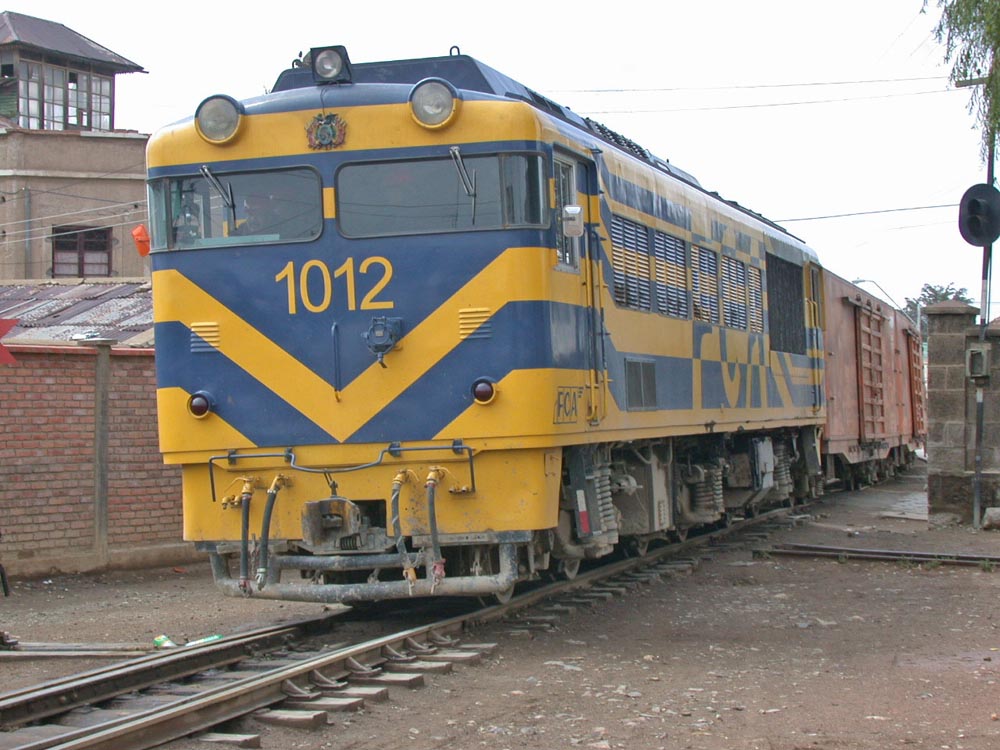The Three Rs - Part One
On Friday 29th June 1963 I
went to Swindon for a medical
examination. My diary records I was first
given an old
shoe box which contained strands of variously coloured wools, all
pretty dirty
from use. When I had sorted them out by
colour, the supervisor was satisfied that I was not colour blind. I then had to write my name on a piece of
paper and then he dictated “A light engine, when on any running line,
must
always carry a red tail lamp in the rear.” I
was flabbergasted to realize that I had just taken a
literacy test (I
had just completed my second year at university) and even more
surprised to
learn that the day before an applicant had made 14 mistakes with those
17
words.
A freight
train arriving at Oruro,
Bolivia. The yard is completely walled in.
Note the cast metal coat of arms of Bolivia
located
above the windshield. While I was taking
this picture our pilotman was getting a copy of his clearance.
I didn’t think much more of this until
almost forty years
later. After my retirement, I spent some
time in Bolivia
training government railway safety inspectors. We
were in a track car in the yard at Oruro on the high (around 14,000
feet)
Altiplano – two government inspectors, the railway division engineer, a
native
Aymara driver/pilotman and me. While we
were waiting for a freight train from Uyuni to clear I asked the driver
to see
his track permit (via libre). He replied,
in Spanish, “It is number one, two, six”. Thinking
that I had made a mistake in my poor Spanish, I
replied “Let me
see it, please”. There then followed a
quick fire exchange in Spanish and Aymara which left the railway
engineer
looking sheepish while the driver went to the dispatching office to get
a paper
copy of his authority. He came back with
a pink via libre, number 126 giving him authority to run all the way to
Uyuni.

Lunch break
at Challapata, Bolivia.
These four wheel inspection cars have to be
used because hy-rail equipment will not function on the narrow (metre)
gauge
track.
Honour was satisfied on both sides and
we ran straight
through to Uyuni where we stayed the night. The
next morning we set off for Potosi
over what was at that time, the highest railway summit in the world. The driver proudly showed me his pink via
libre and we set off for Potosi. We were following a train ahead and the
dispatcher was clearing the line ahead for us as the train proceeded. I kept track of the locations as we
progressed and asked why the driver was not writing down the points to
which we
were cleared as they were given over the radio. There
then followed another quick-fire exchange in Spanish
and Aymara
and the answer was again lost in translation – something about he can
remember
so he doesn’t write it down.
Afterwards, it has become clear to me
that the reason for
the problems was that the Aymara pilotman could not read or write so it
was
useless to give him a written via libre and he could not write down the
extensions to his clearance. Although
the rule book said otherwise, he had to remember this all-important
information. Of course, everyone knew
that once the freight train had arrived at Oruro there were no other
trains
running that day so why did he need a piece of paper to tell him
something that
everyone knew?
The
value of that test taken so many years ago now
became quite clear to me. It is
essential to be able to read and write. Next
time I will talk about the value of the third “R” -
‘rithmetic.
Ottawa
Central Railway, Spareboard, April 2008.
